Movies We Like
Handpicked By The Amoeba Staff
Films selected and reviewed by discerning movie buffs, television junkies, and documentary diehards (a.k.a. our staff).
The Great Escape
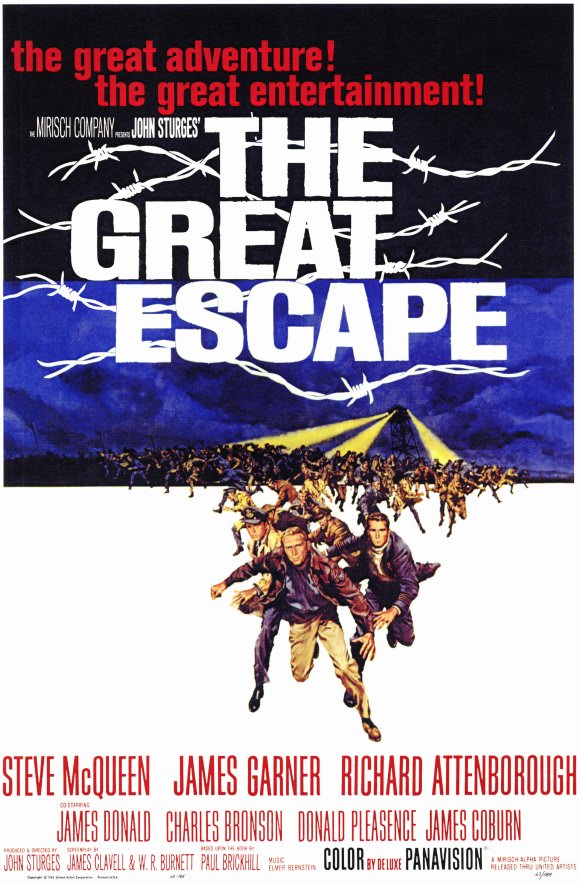 After putting together a super team for the exciting western The Magnificent Seven, director John Sturges assembled the rat-pack for the much duller western, Sergeants 3; so down but not out, Sturges reconvened some of his Magnificent Seven cast for his masterpiece, the WWII POW epic The Great Escape. With apologies to King Rat, Merry Christmas, Mr. Lawrence, Empire of the Sun, The Hill, and even Victory, the official, no- arguments-allowed Big Three of POW flicks are (in order of release): Stalag 17 then The Bridge on the River Kwai, and finally The Great Escape; you can argue which of the Big Three is tops, but all three are wonderful and will rank in any war movie best-of list.
After putting together a super team for the exciting western The Magnificent Seven, director John Sturges assembled the rat-pack for the much duller western, Sergeants 3; so down but not out, Sturges reconvened some of his Magnificent Seven cast for his masterpiece, the WWII POW epic The Great Escape. With apologies to King Rat, Merry Christmas, Mr. Lawrence, Empire of the Sun, The Hill, and even Victory, the official, no- arguments-allowed Big Three of POW flicks are (in order of release): Stalag 17 then The Bridge on the River Kwai, and finally The Great Escape; you can argue which of the Big Three is tops, but all three are wonderful and will rank in any war movie best-of list.
Like the recent action flicks The Expendables or The Avengers, The Great Escape is about assembling the team of super cool (now familiar) faces. The Magnificent Seven put the young supporting Steve McQueen on the A-List. Here, he’s the top dog and it may be his most memorable role; joined by two of the other Seven co-stars, Charles Bronson and James Coburn (who would both go on to be big stars in the years to come), with James Garner bringing his awe-shucks charm that would captivate TV audiences for decades and, rounding out the team, the British actors Richard Attenborough, Donald Pleasence, David McCallum, and James Donald (who was also in The Bridge on the River Kwai), lending some class to the team.
A Decade Under the Influence
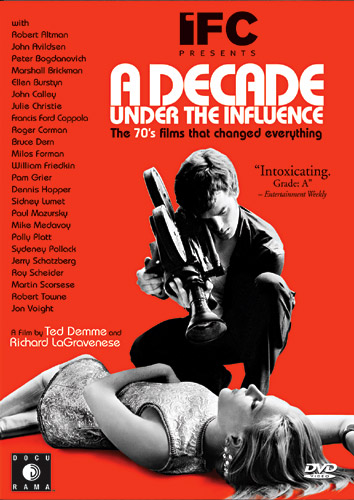 Playing on the title of the groundbreaking John Cassavetes film A Woman Under the Influence, or maybe ’70s cokehead producer Julia Phillips’s memoir Driving Under the Affluence, the IFC-produced, three-part documentary A Decade Under the Influence is a fawning but wildly entertaining tribute to the films of the ’70s (actually 1967 onwards) and the maverick filmmakers who reinvented Hollywood. It’s the perfect film companion to Peter Biskind's incredibly readable book Easy Riders, Raging Bulls, which also spawned a BBC-produced documentary with the same name. The IFC series may come out slightly on top if only because it’s an hour longer and, at just 119 minutes, the BBC flick may not cover enough ground, while A Decade Under the Influence is crammed wall to wall with clips and interviews. For anyone who romanticizes this era in film (like me) this is three hours of pure, giddy love.
Playing on the title of the groundbreaking John Cassavetes film A Woman Under the Influence, or maybe ’70s cokehead producer Julia Phillips’s memoir Driving Under the Affluence, the IFC-produced, three-part documentary A Decade Under the Influence is a fawning but wildly entertaining tribute to the films of the ’70s (actually 1967 onwards) and the maverick filmmakers who reinvented Hollywood. It’s the perfect film companion to Peter Biskind's incredibly readable book Easy Riders, Raging Bulls, which also spawned a BBC-produced documentary with the same name. The IFC series may come out slightly on top if only because it’s an hour longer and, at just 119 minutes, the BBC flick may not cover enough ground, while A Decade Under the Influence is crammed wall to wall with clips and interviews. For anyone who romanticizes this era in film (like me) this is three hours of pure, giddy love.
Episode One: Influences and Independents, begins with the big gaudy premiere of the crappy big gaudy musical Hello Dolly in ’69; the thesis: that bomb marked the end of the studio era. An intelligent group of interviewees, including Francis Ford Coppola, Dennis Hopper, and William Friedkin, give us the set up: the civil rights movement, Vietnam War, the women's movement, ’60s innovative rock & roll and later Watergate, the formation of the counter culture, and youth movement had a generation of people asking why and breaking the rules. For filmmakers who were seeing the art house foreign films of Godard, Kurosawa, Truffaut, Antonioni, Bergman, and Fellini (and of course Julie Christie throws in the working class films of early ’60s England) the current beach flicks, musicals, and romantic comedies of Hollywood no longer seemed relevant. When Arthur Penn took influence from the French New Wave (who were influenced by American film noir and gangster flicks) and came up with his sexually frank and violent Bonnie and Clyde, it opened the floodgates for a new kind of American film. With Roger Corman and BBS (Bob Rafelson, Bert Schneider, and Steve Blauner) creating a new class of filmmakers who could work cheap while learning their trade and John Cassavetes making his homemade indie movies, the idea for the “’70s flick” was solidified. Those early influential flicks of the era are recalled and analyzed, including Easy Rider, Targets, Midnight Cowboy, The French Connection, and The Last Picture Show. But it’s not all classics; less memorable movies like Joe and Hi, Mom! are also included and even Dirty Harry is given props as an obvious influence.
Corman's World: Exploits of a Hollywood Rebel
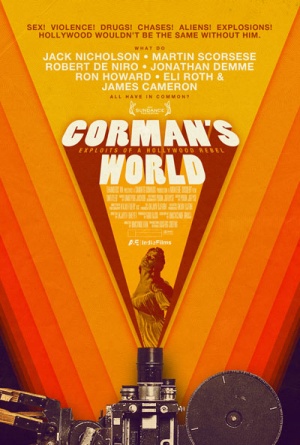 Even if you’re a casual film fan, you must have a general knowledge of who Roger Corman is and how important he’s been to the movie industry. You need look no further than the impressive roaster of names that speak about the prolific filmmaker in the documentary Corman’s World: Exploits Of A Hollywood Rebel. Jack Nicholson. Peter Fonda. Martin Scorsese. Peter Bogdanovich. Joe Dante. Ron Howard. Robert DeNiro. Bruce Dern. Dick Miller. William Shatner. And so on and so forth. Corman is responsible for helping to launch the careers of every one of those names I mentioned above and then some! So it’s somewhat of a surprise that a documentary of this type honoring the man and his large body of work has taken this long to come into existence.
Even if you’re a casual film fan, you must have a general knowledge of who Roger Corman is and how important he’s been to the movie industry. You need look no further than the impressive roaster of names that speak about the prolific filmmaker in the documentary Corman’s World: Exploits Of A Hollywood Rebel. Jack Nicholson. Peter Fonda. Martin Scorsese. Peter Bogdanovich. Joe Dante. Ron Howard. Robert DeNiro. Bruce Dern. Dick Miller. William Shatner. And so on and so forth. Corman is responsible for helping to launch the careers of every one of those names I mentioned above and then some! So it’s somewhat of a surprise that a documentary of this type honoring the man and his large body of work has taken this long to come into existence.
Not that Corman hasn’t gotten due credit and praise in the form of supplemental material before. Over the course of the last year, Shout! Factory obtained the license for dozens of his famous films and has been putting out great special edition DVD’s and Blu-Ray’s with extensive retrospective documentaries covering the making of each of those individual movies. There was also the fantastic documentary Machete Maidens Unleashed released last year from filmmaker Mark Hartley (who also did Not Quite Hollywood: The Wild, Untold Story of Ozploitation) which had a large segment talking about the low-budget “women in cages” movies that Corman produced in the Philippines, which also launched the acting career of Pam Grier. But as much as I thought I knew about Corman from the above mentioned sources, there was still plenty I learned from Corman’s World.
Punisher: War Zone
 As far back as I can remember, I’ve always wished for a proper Punisher movie. As a diehard comic book reader and collector, there was a point where I discovered the idea of vigilantism and The Punisher immediately became my favorite superhero (actually, more like an anti-hero and minus the “super” part since he has no legitimate powers other than being a complete and total badass). With over 30-some-odd years of history and through various directions that comic creators have taken the character, it would seem that there are plenty of great stories to cull from in order to make a solid movie adaptation. But for whatever reason, while all the Punisher movies have incorporated different aspects of the original source material, none of the cinematic translations have been 100 percent successful, either financially at the box office or critically among both reviewers and fans. However, if you’re well-versed in the run by writer Garth Ennis over the course of the last decade or so, then Punisher: War Zone comes pretty darn close to capturing the over-the-top gory lunacy of Ennis’s books.
As far back as I can remember, I’ve always wished for a proper Punisher movie. As a diehard comic book reader and collector, there was a point where I discovered the idea of vigilantism and The Punisher immediately became my favorite superhero (actually, more like an anti-hero and minus the “super” part since he has no legitimate powers other than being a complete and total badass). With over 30-some-odd years of history and through various directions that comic creators have taken the character, it would seem that there are plenty of great stories to cull from in order to make a solid movie adaptation. But for whatever reason, while all the Punisher movies have incorporated different aspects of the original source material, none of the cinematic translations have been 100 percent successful, either financially at the box office or critically among both reviewers and fans. However, if you’re well-versed in the run by writer Garth Ennis over the course of the last decade or so, then Punisher: War Zone comes pretty darn close to capturing the over-the-top gory lunacy of Ennis’s books.
The movie wastes little time in getting right into the violent action. After a brief title sequence, the film opens at a grand dinner gala with several heads of the mob congregating to discuss business and celebrate with Uncle G, the Godfather-esque elder of the East Coast mafia. But their dinner is cut abruptly short when the Punisher drops in and literally slaughters just about all 30 of these bad guys in the span of a few short minutes. The action is brutal, highly stylized, fast in pace, and so over the top that you won’t be able to process everything going on with just one viewing. The Punisher manages to cut a head off, break a neck, lodge his hunter knife into a skull, kick a chair leg into the eye of a thug, then hang upside down from the chandelier where he unloads a never-ending spray of bullets from his machine guns into whomever is left in the room, as well as anyone else stupid enough to enter it. Did I mention this is all just in the first 10 minutes?
Blazing Saddles
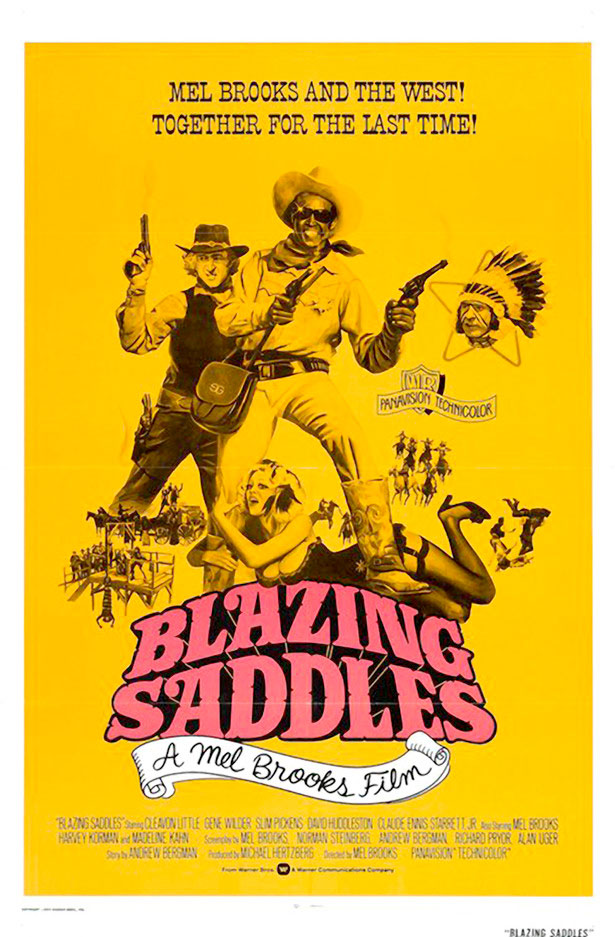 Once upon a time in the golden period of films known as the 1970s, Mel Brooks was, along with Woody Allen, the biggest directing name in comedy. Both had been on the legendary writing staff of Sid Caesar's Your Show of Shows in the '50s (along with Neil Simon and Carl Reiner) and both brought a distinctly Jewish tone to their slapstick. While Allen represented the Manhattan highbrow, Brooks’s style lurked more in the offensively low end Borscht Belt style. By the '80s, when Allen's status raised to the level of genius, Brooks’s comedy had already become passe and completely juvenile, working in the obvious (Spaceballs, Dracula: Dead and Loving It, etc.). But his early string of comedies, from The Producers through High Anxiety, created a lot of laughs, peaking in 1974 with two comic masterpieces: Young Frankenstein and, maybe even better, the bawdy western spoof Blazing Saddles.
Once upon a time in the golden period of films known as the 1970s, Mel Brooks was, along with Woody Allen, the biggest directing name in comedy. Both had been on the legendary writing staff of Sid Caesar's Your Show of Shows in the '50s (along with Neil Simon and Carl Reiner) and both brought a distinctly Jewish tone to their slapstick. While Allen represented the Manhattan highbrow, Brooks’s style lurked more in the offensively low end Borscht Belt style. By the '80s, when Allen's status raised to the level of genius, Brooks’s comedy had already become passe and completely juvenile, working in the obvious (Spaceballs, Dracula: Dead and Loving It, etc.). But his early string of comedies, from The Producers through High Anxiety, created a lot of laughs, peaking in 1974 with two comic masterpieces: Young Frankenstein and, maybe even better, the bawdy western spoof Blazing Saddles.
The western spoof is almost as old as the western itself—you had Laurel & Hardy in Way Out West, The Marx Brothers in Go West, Mae West and W.C. Fields did My Little Chickadee, and Bob Hope had The Paleface and then Son of Paleface, not to mention Destry Rides Again with Marlene Dietrich (which Blazing Saddles actually directly spoofs). The '60s saw an examining of the western most directly through the Italian spaghetti westerns and American western comedies such as Cat Ballou and Support Your Local Sheriff! In the '70s, the reexamining went to the extreme as the western was turned in on itself and poked at by post-modernists with films as broad as Jodorowsky’s El Topo, Altman’s Buffalo Bill and the Indians, or Sitting Bull's History Lesson, to the sci-fi camp of Westworld. Blazing Saddles is more than a spoof; it’s one of the rare big laugh comedies that actually has something to say about contemporary racial politics, making it much closer to the later, intellectually ambitious films than the earlier yuk-fests.
Reds
 In 1981, with newly elected rah-rah American president Ronald Reagan taking office, an anti-Communist, anti-Soviet ardor was in full swing. So it was extra amazingly audacious that pretty-boy actor Warren Beatty was able to get his giant bio of Communist journalist John Reed made. Reed, the only American buried in Russia’s Kremlin, isn’t exactly a household name and Reds the movie, clocking in at an epic 194 minutes, wasn’t exactly a sure thing at the box-office (matter of fact, despite winning a bunch of awards, it was considered a financial disappointment in its day). Reds really is a tribute to the passion of Warren Beatty’s grand vision; he produced, directed, and co-wrote the screenplay with British playwright Trevor Griffiths (with uncredited contributions from Elaine May) and managed to put together an impressive cast to back him up (Diane Keaton, Jack Nicholson, Edward Herrmann, Paul Sorvino, Maureen Stapleton, Gene Hackman, etc). Ironic: a rich movie star makes a big expensive movie (with corporate funds) about an anti-wealth guy. In the Doctor Zhivago tradition, Reds is one of those sweeping literate love stories which was shot for over a year in five different countries; but underneath that sweep it’s a very personal and intimate little movie.
In 1981, with newly elected rah-rah American president Ronald Reagan taking office, an anti-Communist, anti-Soviet ardor was in full swing. So it was extra amazingly audacious that pretty-boy actor Warren Beatty was able to get his giant bio of Communist journalist John Reed made. Reed, the only American buried in Russia’s Kremlin, isn’t exactly a household name and Reds the movie, clocking in at an epic 194 minutes, wasn’t exactly a sure thing at the box-office (matter of fact, despite winning a bunch of awards, it was considered a financial disappointment in its day). Reds really is a tribute to the passion of Warren Beatty’s grand vision; he produced, directed, and co-wrote the screenplay with British playwright Trevor Griffiths (with uncredited contributions from Elaine May) and managed to put together an impressive cast to back him up (Diane Keaton, Jack Nicholson, Edward Herrmann, Paul Sorvino, Maureen Stapleton, Gene Hackman, etc). Ironic: a rich movie star makes a big expensive movie (with corporate funds) about an anti-wealth guy. In the Doctor Zhivago tradition, Reds is one of those sweeping literate love stories which was shot for over a year in five different countries; but underneath that sweep it’s a very personal and intimate little movie.
After covering events in Russia, journalist John Reed (Beatty) returns to his home town of Portland to raise money for his ultra-left newspaper. There, he meets and has a fling with a married socialite named Louise Bryant (Keaton) and invites her back to New York's bohemian Greenwich Village where they both hang with many of the famous radicals of their day, like the outspoken anarchist Emma Goldman (Stapleton). Reed encourages Bryant to become a writer herself; she develops her own form of ahead-of- her-time feminism while he throws himself deeper into the Communist Party. After the couple moves to Provincetown, Massachusetts, Reed travels the country to cover the presidential election, while Bryant begins an affair with Reed’s friend, the tortured playwright Eugene O’Neill (Nicholson), the one intellectual who seems to respect her. Then, Reed and Bryant patch things up and first travel to write about the war in Europe (that would be WWI) and then to cover the revolution in Russia of 1917. And that’s just the first half.
New Jack City
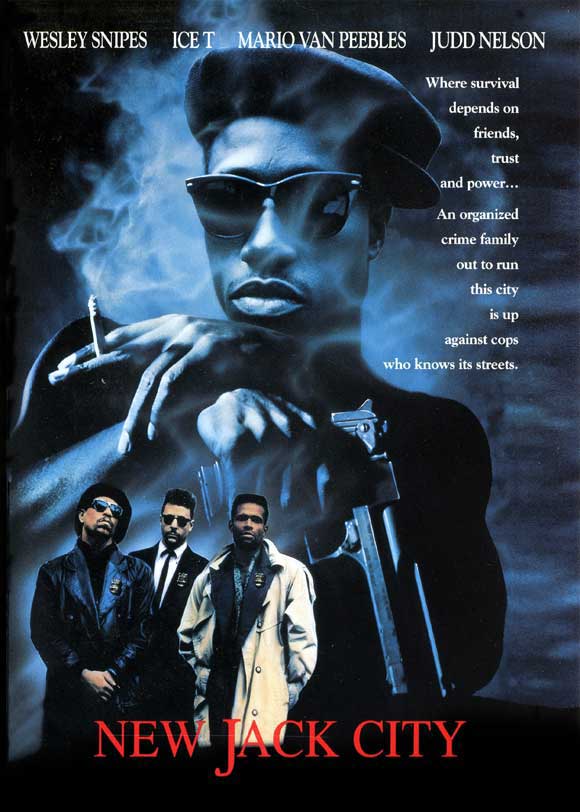 Going back all the way to the beginning of the talkies, the gangster flick, with its rise-and-fall narrative, has always been a dependable formula for Hollywood. And whether it’s Cagney or Pacino, the movies seem to have more fun with the “rise,” while the “fall” often feels like a tacked on message to mitigate how glamorous the first half may have seemed. The inner-city crime saga New Jack City is no different; though characters may take the high road and exclaim to the camera about how much the crack epidemic is ravishing the hood, really it’s an excuse to show the playas living large with their champagne in the pool, nifty guns, foxy ladies, and horribly colorful 1991 hip-hoppity fashions. And like so many gangster flicks before and since, New Jack City is a lot of fun and, as long as you don’t try to buy into its sermonizing, it holds up well as a cartoony period piece.
Going back all the way to the beginning of the talkies, the gangster flick, with its rise-and-fall narrative, has always been a dependable formula for Hollywood. And whether it’s Cagney or Pacino, the movies seem to have more fun with the “rise,” while the “fall” often feels like a tacked on message to mitigate how glamorous the first half may have seemed. The inner-city crime saga New Jack City is no different; though characters may take the high road and exclaim to the camera about how much the crack epidemic is ravishing the hood, really it’s an excuse to show the playas living large with their champagne in the pool, nifty guns, foxy ladies, and horribly colorful 1991 hip-hoppity fashions. And like so many gangster flicks before and since, New Jack City is a lot of fun and, as long as you don’t try to buy into its sermonizing, it holds up well as a cartoony period piece.
Here, the cops and dealers are showcased equally. For the good guys, you have undercover NY cop Scotty Appleton (rapper Ice-T, in his first lead acting role); he may be tough but he shows some heart to a junkie stick-up kid named Pookie, (comedian Chris Rock, in a rare dramatic performance that may’ve encouraged him to work on his stand-up more). Scotty helps him kick the dope after busting him. Meanwhile, on the other side of the tracks, dealer Nino Brown (Wesley Snipes) is able to enhance his business when he is introduced to a new cocaine concoction called “crack.” With his top lieutenants, Gee Money (Allen Payne) and Duh Duh Duh Man (Bill Nunn, Radio Raheem in Do the Right Thing) they get the posse together (called the "Cash Money Brothers") and take over an apartment building, turning it into a successful crack assembly line and retail outlet.
The Mask
 It’s interesting to revisit Chuck Russell’s 1994 adaptation of The Mask, now almost 20 some-odd years later knowing that this was the second of three Jim Carrey movies (the other two being Ace Ventura: Pet Detective and Dumb & Dumber) that would catapult the funnyman into super stardom. Also, considering that this is a far cry from the original comic book version of the character in which the Mask was conceived as a darker and more violent vigilante, who would’ve thought that when Dark Horse Comics first debuted the character he’d eventually spawn an animated series and kid friendly sequel?! But I digress…
It’s interesting to revisit Chuck Russell’s 1994 adaptation of The Mask, now almost 20 some-odd years later knowing that this was the second of three Jim Carrey movies (the other two being Ace Ventura: Pet Detective and Dumb & Dumber) that would catapult the funnyman into super stardom. Also, considering that this is a far cry from the original comic book version of the character in which the Mask was conceived as a darker and more violent vigilante, who would’ve thought that when Dark Horse Comics first debuted the character he’d eventually spawn an animated series and kid friendly sequel?! But I digress…
In the movie, Jim Carrey plays Stanley Ipkiss, a mild-mannered, overly nice and yet kind-of nerdy bank teller who, for the most part, can’t catch a break anywhere in his personal life. His female co-workers don’t want to date him (and in fact, take advantage of his niceness); his boss is always riding him (despite him being a model employee), and he’s even getting ripped off by his local mechanics. His best friend Charlie (the late Richard Jeni) believes in him, though, and tries to boost his confidence by bringing him out to the hot new club in Edge City, the Coco Bongo. Meanwhile, gangster (and Coco Bongo manager) Dorian Tyrell (Peter Greene) is plotting the hostile takeover of city turf from mob boss Niko once he and his crew have established their cred by pulling off a risky bank robbery.
Notorious
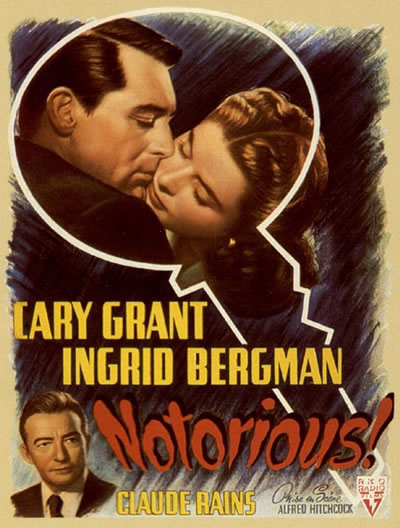 The massive career of Alfred Hitchcock can be broken down into three sections. There’s his early British career (that includes both silent films and talkies) that ends with Jamaica Inn in 1939. Then there’s the first half of his American period; he crossed the ocean and found instant success with Rebecca and continued to hone his craft and try out different genres during the 1940s and early ‘50s. And then finally there’s his most celebrated period beginning around ’54 with Rear Window and Dial M for Murder, where the name Hitchcock became a brand and most of his films were events in themselves. Of that middle period, besides Rebecca there are a number of celebrated and still admired flicks including Spellbound, Shadow of a Doubt, and Strangers on a Train. But one film that really stands out, less flashy than the others but more emotionally devastating, is Notorious. On paper it’s an espionage thriller, but it’s actually one of the great heartbreaking love stories of the era.
The massive career of Alfred Hitchcock can be broken down into three sections. There’s his early British career (that includes both silent films and talkies) that ends with Jamaica Inn in 1939. Then there’s the first half of his American period; he crossed the ocean and found instant success with Rebecca and continued to hone his craft and try out different genres during the 1940s and early ‘50s. And then finally there’s his most celebrated period beginning around ’54 with Rear Window and Dial M for Murder, where the name Hitchcock became a brand and most of his films were events in themselves. Of that middle period, besides Rebecca there are a number of celebrated and still admired flicks including Spellbound, Shadow of a Doubt, and Strangers on a Train. But one film that really stands out, less flashy than the others but more emotionally devastating, is Notorious. On paper it’s an espionage thriller, but it’s actually one of the great heartbreaking love stories of the era.
Just after WWII, Alicia Huberman (Ingrid Bergman), the party girl daughter of a convicted Nazi spy, is recruited by an American Intelligence agent, T. R. Devlin (Cary Grant), to prove her love to the red, white, & blue by infiltrating a group of Nazis who are hanging out in Brazil, planning a little postwar revenge against the USA. Things get complicated when, while waiting for the job to start, the two beautiful people fall in love. When the details arrive, it’s ugly; she has to go seduce an older ex-boyfriend, Alex Sebastian (Claude Rains), and find out what he and his cronies have in mind. She desperately wants Devlin to stand by and trust her; but though he does genuinely love her, he’s too cool to put down his guard and too professional to stop his bosses from deploying her. Still hoping to end up with Devlin, the dutiful Alicia takes the job and seduces Sebastian so well that he asks her to marry him, even while knowing she may be setting him up. It’s a love triangle, but in a twisted kind of knot that only Hitchcock could devise.
Kingpin
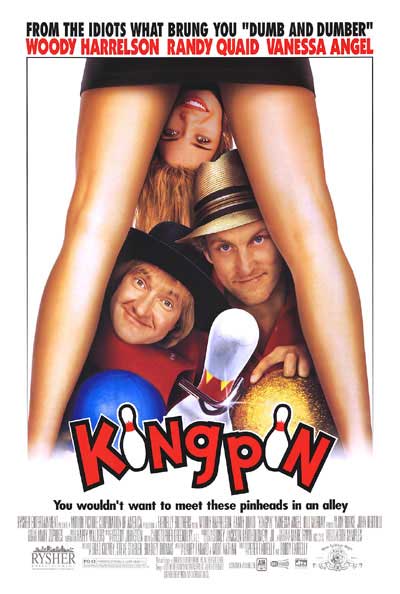 Though they hit the big-time as screenwriters and directors with their first film, Dumb & Dumber, the Farrelly brothers, Peter and Bobby, peaked commercially and critically with their third film, There’s Something about Mary. Their gross-out, dumb humor mixed with lazy sentiment became the standard for turn-of-the-century-era comedy; however, it was actually their less popular second film, Kingpin, which remains their best and funniest flick. It has the raunch, it has some heart, but most importantly, what makes the film special is the outstanding casting of its three leads: Woody Harrelson, Randy Quaid, and Bill Murray. Their performances, along with some of the supporting character actors, help the film rise above its sometimes weak script. Kingpin may not always bowl strikes but it is at least good enough to share a lane with the other best bowling movie ever, The Big Lebowski.
Though they hit the big-time as screenwriters and directors with their first film, Dumb & Dumber, the Farrelly brothers, Peter and Bobby, peaked commercially and critically with their third film, There’s Something about Mary. Their gross-out, dumb humor mixed with lazy sentiment became the standard for turn-of-the-century-era comedy; however, it was actually their less popular second film, Kingpin, which remains their best and funniest flick. It has the raunch, it has some heart, but most importantly, what makes the film special is the outstanding casting of its three leads: Woody Harrelson, Randy Quaid, and Bill Murray. Their performances, along with some of the supporting character actors, help the film rise above its sometimes weak script. Kingpin may not always bowl strikes but it is at least good enough to share a lane with the other best bowling movie ever, The Big Lebowski.
Back in the disco days of the late ‘70s, a young Iowan man, Roy Munson (Harrelson), looked like he was on his way to becoming a bowling god, until he hooked up with a conniving pro-bowler named Ernie McCracken (Murray) for a little hustling. The naive Roy didn’t realize that the sleazy Ernie, who drinks Tanqueray & Tab, was threatened by the younger bowler’s talent and leading him astray. A bad con with the wrong guys leads to Roy getting his hand cut off and the end to his promising bowling future. CUT TO: 17 years later. Roy now sports a prosthetic hand (over a hook) and a bad comb over haircut. He’s down and out, a drunk and bad conman forced to sleep with his hideously haggish landlady (Lin Shaye, brilliant) to cover his rent. Roy has hit the bottom until he happens upon a naive young Amish bowler, Ishmael Boorg (Quaid, the 40-something actor seems to be playing about 20). After much coercing and posing as an Amish cousin Roy finally convinces Ishmael to hit the bowling road with him to learn the con and eventually play for the big-time, where Ishmael can earn money to save the family farm.











